Entropy Analysis of EMHD Hybrid Nanofluid Stagnation Point Flow over a Porous Stretching Sheet with Melting Heat Transfer in the Presence of Thermal Radiation
Abstract
1. Introduction
2. Mathematical Formulation
- The velocity of the stretching sheet is and the outer flow velocity of is , where and both are positive constants.
- The boundary layer equations of the fluid flow are composed from the continuity equation, the momentum equation and the energy equation, which are formulated based on Maxwell’s equation and Ohm’s law.
- The effects of a magnetic field and an electric field on the incompressible flow of a viscous fluid are considered.
- The magnetic and electric fields obey Ohm’s law defining magnetic induction as , where σ is the electric conductivity, represents the fluid velocity and flui the current.
- The melting surface and ambient temperature are represented by and , where .
- A magnetic field and electric field are applied normal to the flow, such that the Reynolds number is assumed to be smaller. The induced magnetic field is smaller than applied magnetic field. As a result, for low magnetic Reynolds numbers, the induced magnetic field is ignored.
- Entropy analysis is also taken into account.
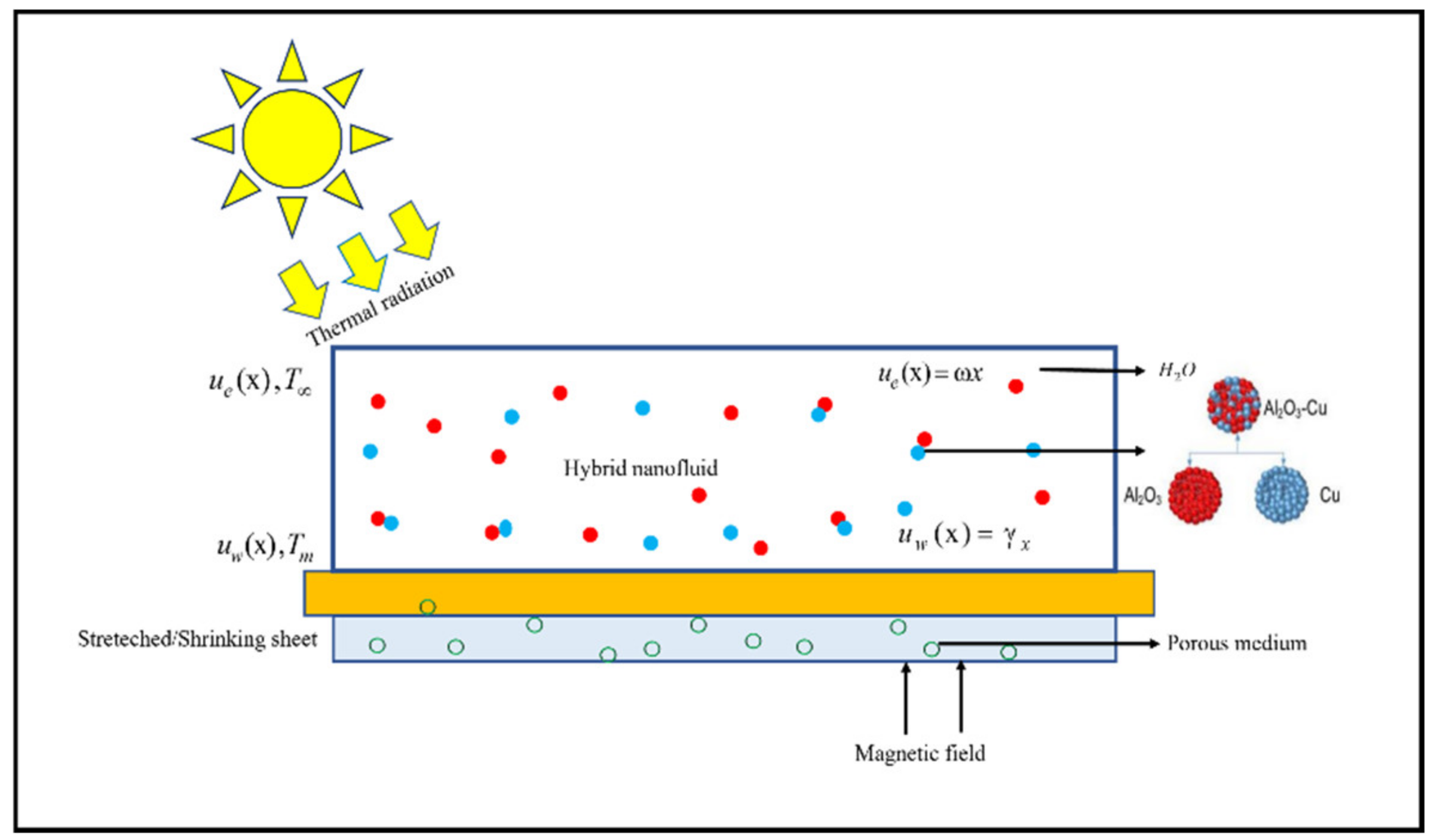
3. Entropy Analysis or Analysis of Energy Loss
4. Solution for Numerical Technique
5. Results and Discussion
6. Conclusions
- The velocity profile decreases when the magnetic parameter and porous medium are increased.
- As increasing the value of electric field, the momentum boundary layer is increases
- The thermal boundary layer expands as the magnetic parameter, radiation parameter, heat source and Eckert number are raised.
- Increases in radiation parameter and magnetic field cause an increase in the rate of entropy generation.
- The Bejan number rises as the Brinkman number rises, but the magnetic field shows the opposite trend.
Author Contributions
Funding
Data Availability Statement
Conflicts of Interest
Nomenclature
| A1, A2, A3, A4, A5 | Hybrid nanofluid constants |
| Magnetic field strength | |
| Bejan number | |
| Brinkman number | |
| Skin friction | |
| Electric field strength (N/C) | |
| Electric parameter | |
| Eckert number | |
| Temperature | |
| Wall temperature | |
| Velocity of the sheet | |
| Magnetic parameter | |
| Melting parameter | |
| Local entropy generation | |
| Local Nusselt number | |
| Radiation parameter | |
| Prandtl number | |
| Porous medium | |
| Parameter of heat source/sink | |
| Stretching parameter | |
| Greek symbols | |
| Thermal expansion | |
| Viscosity | |
| Density | |
| Electrical conductivity | |
| Volume fraction of nanoparticles | |
| Heat capacity of the hybrid nanofluid | |
| Heat capacity of the fluid | |
| Heat capacity of the nanoparticles’ material | |
| Thermal conductivity of the hybrid nanofluid | |
| Viscosity of hybrid nanofluid | |
| Fluid kinematic viscosity | |
| Subscripts | |
| Fluid | |
| Hybrid nanofluid | |
| Solid particle | |
| Condition at the sheet | |
| Ambient conditions. |
References
- Choi, S.U.S.; Eastman, J. Enhancing thermal conductivity of fluids with nanoparticles. In Proceedings of the 1995 ASME International Mechanical Engineering Congress & Exposition, San Francisco, CA, USA, 12–17 November 1995; pp. 99–105. [Google Scholar]
- Kameswaran, P.K.; Narayana, M.; Sibanda, P.; Murthy, P.V. Hydromagnetic nanofluid flow due to a stretching or shrinking sheet with viscous dissipation and chemical reaction effects. Int. J. Heat Mass Transf. 2012, 55, 7587–7595. [Google Scholar] [CrossRef]
- Kumaresan, E.; Vijaya Kumar, A.G. Chemically reactive 3D nonlinear magneto hydrodynamic rotating flow of nanofluids over a deformable surface with joule heating through porous medium. In Applied Mathematics and Scientific Computing; Springer: Cham, Switzerland, 2019; pp. 313–323. [Google Scholar]
- Jana, S.; Salehi-Khojin, A.; Zhong, W.H. Enhancement of fluid thermal conductivity by the addition of single and hybrid nano-additives Lithium-Sulfur Batteries View project Lithium sulfur battery View project Enhancement of fluid thermal conductivity by the addition of single and hybrid nano-additives. Thermochim. Acta 2007, 462, 45–55. [Google Scholar]
- Kumar, T.S. Hybrid nanofluid slip flow and heat transfer over a stretching surface. Partial. Differ. Equ. Appl. Math. 2021, 4, 100070. [Google Scholar] [CrossRef]
- Suresh, S.; Venkitaraj, K.P.; Selvakumar, P.; Chandrasekar, M. Effect of Al2O3–Cu/water hybrid nanofluid in heat transfer. Exp. Therm. Fluid Sci. 2012, 38, 54–60. [Google Scholar] [CrossRef]
- Suresh, S.; Venkitaraj, K.P.; Hameed, M.S.; Sarangan, J. Turbulent Heat Transfer and Pressure Drop Characteristics of Dilute Water Based Al2O3–Cu Hybrid Nanofluids. J. Nanosci. Nanotechnol. 2014, 14, 2563–2572. [Google Scholar] [CrossRef] [PubMed]
- Bhattad, A. Experimental investigation of Al2O3–MgO hot hybrid nanofluid in a plate heat exchanger. Heat Transf. 2020, 49, 2344–2354. [Google Scholar] [CrossRef]
- Selimefendigil, F.; Öztop, H.F.; Chamkha, A.J. MHD mixed convection and entropy generation of nanofluid filled lid driven cavity under the influence of inclined magnetic fields imposed to its upper and lower diagonal triangular domains. J. Magn. Magn. Mater. 2016. ahead of print. [Google Scholar] [CrossRef]
- Selimefendigil, F.; Öztop, H.F. Corrugated conductive partition effects on MHD free convection of CNT-water nanofluid in a cavity. Int. J. Heat Mass Transf. 2019, 129, 265–277. [Google Scholar] [CrossRef]
- Sheremet, M.; Pop, I.; Öztop, H.F.; Abu-Hamdeh, N. Natural convection of nanofluid inside a wavy cavity with a non-uniform heating: Entropy generation analysis. Int. J. Numer. Methods Heat Fluid Flow 2017, 27, 958–980. [Google Scholar] [CrossRef]
- Shah, Z.; Bonyah, E.; Islam, S.; Gul, T. Impact of thermal radiation on electrical MHD rotating flow of Carbon nanotubes over a stretching sheet. AIP Adv. 2019, 9, 15115. [Google Scholar] [CrossRef]
- Daniel, Y.S.; Aziz, Z.A.; Ismail, Z.; Bahar, A. Unsteady EMHD dual stratified flow of nanofluid with slips impacts. Alex. Eng. J. 2020, 59, 177–189. [Google Scholar] [CrossRef]
- Abbas, T.; Hayat, T.; Ayub, M.; Bhatti, M.M.; Alsaedi, A. Electromagnetohydrodynamic nanofluid flow past a porous Riga plate containing gyrotactic microorganism. Neural Comput. Appl. 2019, 31, 1905–1913. [Google Scholar] [CrossRef]
- Jakeer, S.; Bala Anki Reddy, P. Entropy generation on EMHD stagnation point flow of hybrid nanofluid over a stretching sheet: Homotopy perturbation solution. Phys. Scr. 2020, 95, 125203. [Google Scholar] [CrossRef]
- Ayub, M.; Abbas, T.; Bhatti, M.M. Inspiration of slip effects on electromagnetohydrodynamics (EMHD) nanofluid flow through a horizontal Riga plate. Eur. Phys. J. Plus 2016, 131, 193. [Google Scholar] [CrossRef]
- Nayak, M.K.; Mabood, F.; Dogonchi, A.S.; Khan, W.A. Electromagnetic flow of SWCNT/MWCNT suspensions with optimized entropy generation and cubic auto catalysis chemical reaction. Int. Commun. Heat Mass Transf. 2021, 120, 104996. [Google Scholar] [CrossRef]
- Rashid, M.; Shahzadi, I.; Nadeem, S. Corrugated walls analysis in microchannels through porous medium under Electromagnetohydrodynamic (EMHD) effects. Results Phys. 2018, 9, 171–182. [Google Scholar] [CrossRef]
- Zheng, L.; Niu, J.; Zhang, X.; Ma, L. Dual solutions for flow and radiative heat transfer of a micropolar fluid over stretching/shrinking sheet. Int. J. Heat Mass Transf. 2012, 55, 7577–7586. [Google Scholar] [CrossRef]
- Warke, A.S.; Ramesh, K.; Mebarek-Oudina, F.; Abidi, A. Numerical investigation of the stagnation point flow of radiative magnetomicropolar liquid past a heated porous stretching sheet. J. Therm. Anal. Calorim. 2022, 147, 6901–6912. [Google Scholar] [CrossRef]
- Daniel, Y.S.; Aziz, Z.A.; Ismail, Z.; Salah, F. Effects of slip and convective conditions on MHD flow of nanofluid over a porous nonlinear stretching/shrinking sheet. Aust. J. Mech. Eng. 2017, 16, 213–229. [Google Scholar] [CrossRef]
- Prakash, J.; Tripathi, D.; Beg, O.A.; Srivastava, V. EMHD Casson Hybrid Nanofluid Flow over an Exponentially Accelerated Rotating Porous Surface. J. Porous Media 2022, 25, 1–24. [Google Scholar] [CrossRef]
- Singh, K.; Kumar, M.; Pandey, A.K. Melting and chemical reaction effects in stagnation point flow of micropolar fluid over a stretchable porous medium in the presence of nonuniform heat source/sink. J. Porous Media 2020, 23, 767–781. [Google Scholar] [CrossRef]
- Khatun, S.; Islam, M.M.; Mollah, M.; Poddar, S.; Alam, M. EMHD radiating fluid flow along a vertical Riga plate with suction in a rotating system. SN Appl. Sci. 2021, 3, 452. [Google Scholar] [CrossRef]
- Mallikarjuna, H.B.; Nirmala, T.; Punith Gowda, R.J.; Manghat, R.; Varun Kumar, R.S. Two-dimensional Darcy–Forchheimer flow of a dusty hybrid nanofluid over a stretching sheet with viscous dissipation. Heat Transf. 2021, 50, 3934–3947. [Google Scholar] [CrossRef]
- Koriko, O.K.; Adegbie, K.S.; Shah, N.A.; Animasaun, I.L.; Olotu, M.A. Numerical solutions of the partial differential equations for investigating the significance of partial slip due to lateral velocity and viscous dissipation: The case of blood-gold Carreau nanofluid and dusty fluid. Numer. Methods Partial. Differ. Equ. 2021. ahead of print. [Google Scholar] [CrossRef]
- Gireesha, B.J.; Sowmya, G.; Khan, M.I.; Öztop, H.F. Flow of hybrid nanofluid across a permeable longitudinal moving fin along with thermal radiation and natural convection. Comput. Methods Programs Biomed. 2020, 185, 105166. [Google Scholar] [CrossRef]
- Awais, M.; Awan, S.E.; Raja, M.A.; Shoaib, M. Effects of Gyro-Tactic Organisms in Bio-convective Nano-material with Heat Immersion, Stratification, and Viscous Dissipation. Arab. J. Sci. Eng. 2020, 46, 5907–5920. [Google Scholar] [CrossRef]
- Gopal, D.; Saleem, S.; Jagadha, S.; Ahmad, F.; Almatroud, A.O.; Kishan, N. Numerical analysis of higher order chemical reaction on electrically MHD nanofluid under influence of viscous dissipation. Alex. Eng. J. 2021, 60, 1861–1871. [Google Scholar] [CrossRef]
- Aziz, A.; Jamshed, W.; Aziz, T.; Bahaidarah, H.; Ur Rehman, K. Entropy analysis of Powell–Eyring hybrid nanofluid including effect of linear thermal radiation and viscous dissipation. J. Therm. Anal. Calorim. 2021, 143, 1331–1343. [Google Scholar] [CrossRef]
- Jawad, M.; Khan, Z.; Bonyah, E.; Jan, R. Analysis of Hybrid Nanofluid Stagnation Point Flow over a Stretching Surface with Melting Heat Transfer. Math. Probl. Eng. 2022, 2022, 9469164. [Google Scholar] [CrossRef]
- Irfan, M.; Farooq, M.A.; Iqra, T. A New Computational Technique Design for EMHD Nanofluid Flow Over a Variable Thickness Surface with Variable Liquid Characteristics. Front. Phys. 2020, 8, 66. [Google Scholar] [CrossRef]
- Reddisekhar Reddy, S.R.; Bala Anki Reddy, P.; Sandeep, N. Numerical study on slip effects on aligned magnetic field flow over a permeable stretching surface with thermal radiation and viscous dissipation. IOP Conf. Ser. Mater. Sci. Eng. 2017, 263, 062003. [Google Scholar] [CrossRef]
- Tlili, I.; Nabwey, H.A.; Ashwinkumar, G.P.; Sandeep, N. 3-D magnetohydrodynamic AA7072-AA7075/methanol hybrid nanofluid flow above an uneven thickness surface with slip effect. Sci. Rep. 2020, 10, 4265. [Google Scholar] [CrossRef] [PubMed]
- Roberts, L. On the melting of a semi-infinite body of ice placed in a hot stream of air. J. Fluid Mech. 1958, 4, 505–528. [Google Scholar] [CrossRef]
- Wu, L. A slip model for rarefied gas flows at arbitrary Knudsen number. Appl. Phys. Lett. 2008, 93, 253103. [Google Scholar] [CrossRef]
- Divya, A.; Reddy, P.B.A. Electromagnetohydrodynamic unsteady flow with entropy generation and hall current of hybrid nanofluid over a rotating disk: An application in hyperthermia therapeutic aspects. Proc. Inst. Mech. Eng. Part C J. Mech. Eng. Sci. 2022, 236, 7511–7528. [Google Scholar] [CrossRef]
- Bala Anki Reddy, P.; Jakeer, S.; Thameem Basha, H.; Reddy Reddisekhar Reddy, S. Multi-layer artificial neural network modeling of entropy generation on MHD stagnation point flow of Cross-nanofluid. Waves Random Complex Media 2022. ahead of print. [Google Scholar] [CrossRef]
- Reddy, P.B.; Salah, T.; Jakeer, S.; Mansour, M.A.; Rashad, A.M. Entropy generation due to magneto-natural convection in a square enclosure with heated corners saturated porous medium using Cu/water nanofluid. Chin. J. Phys. 2022, 77, 1863–1884. [Google Scholar] [CrossRef]
- Kayalvizhi, J.; Vijaya Kumar, A.G. Ramping Wall Boundary Analysis of Buoyant-Driven Convection Magnetohydrodynamics (MHD) Flow of B–H2O and Al2O3–H2O Nanofluid Past Vertical Edge in a Porous Zone. J. Nanofluids 2022, 11, 879–894. [Google Scholar] [CrossRef]

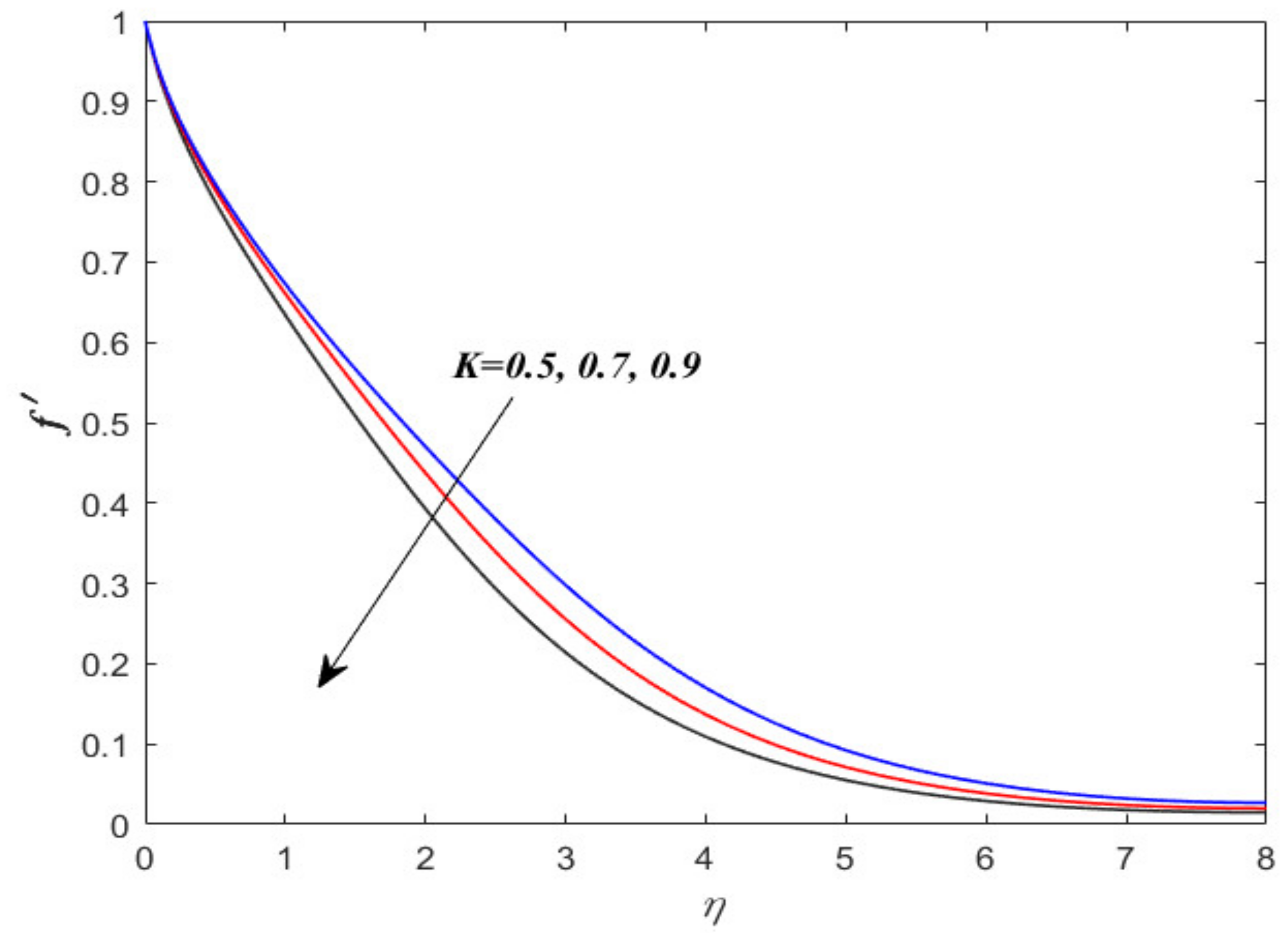
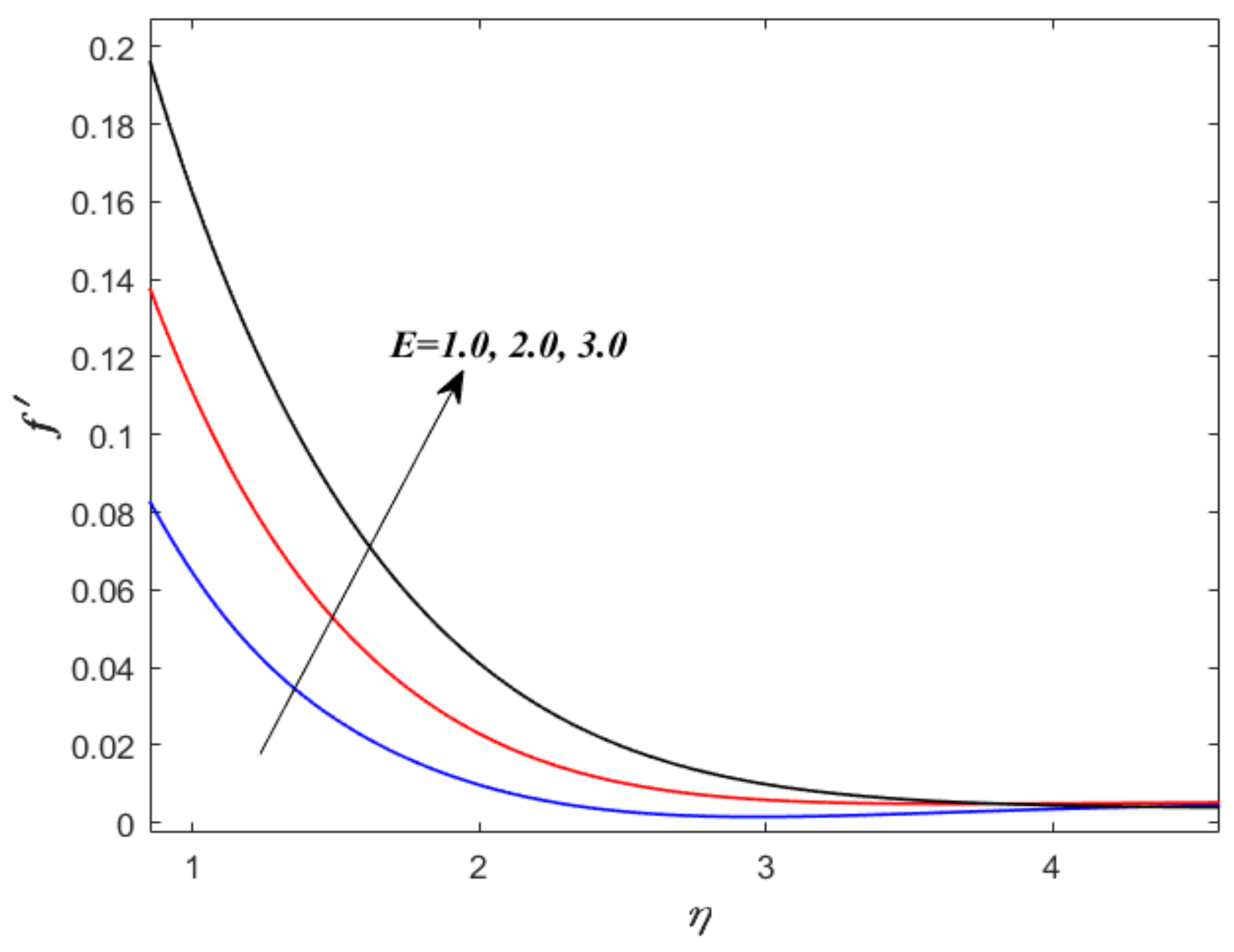
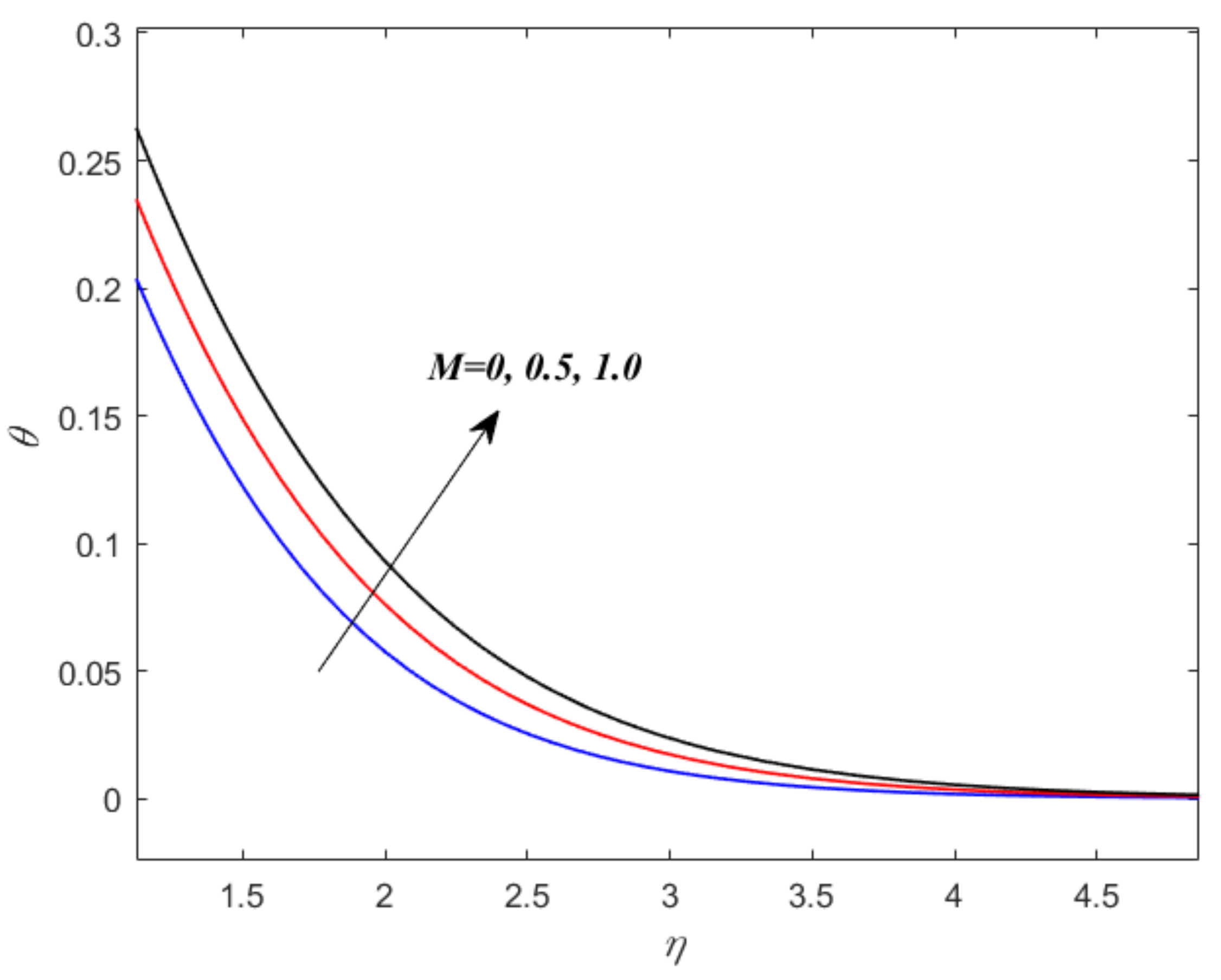
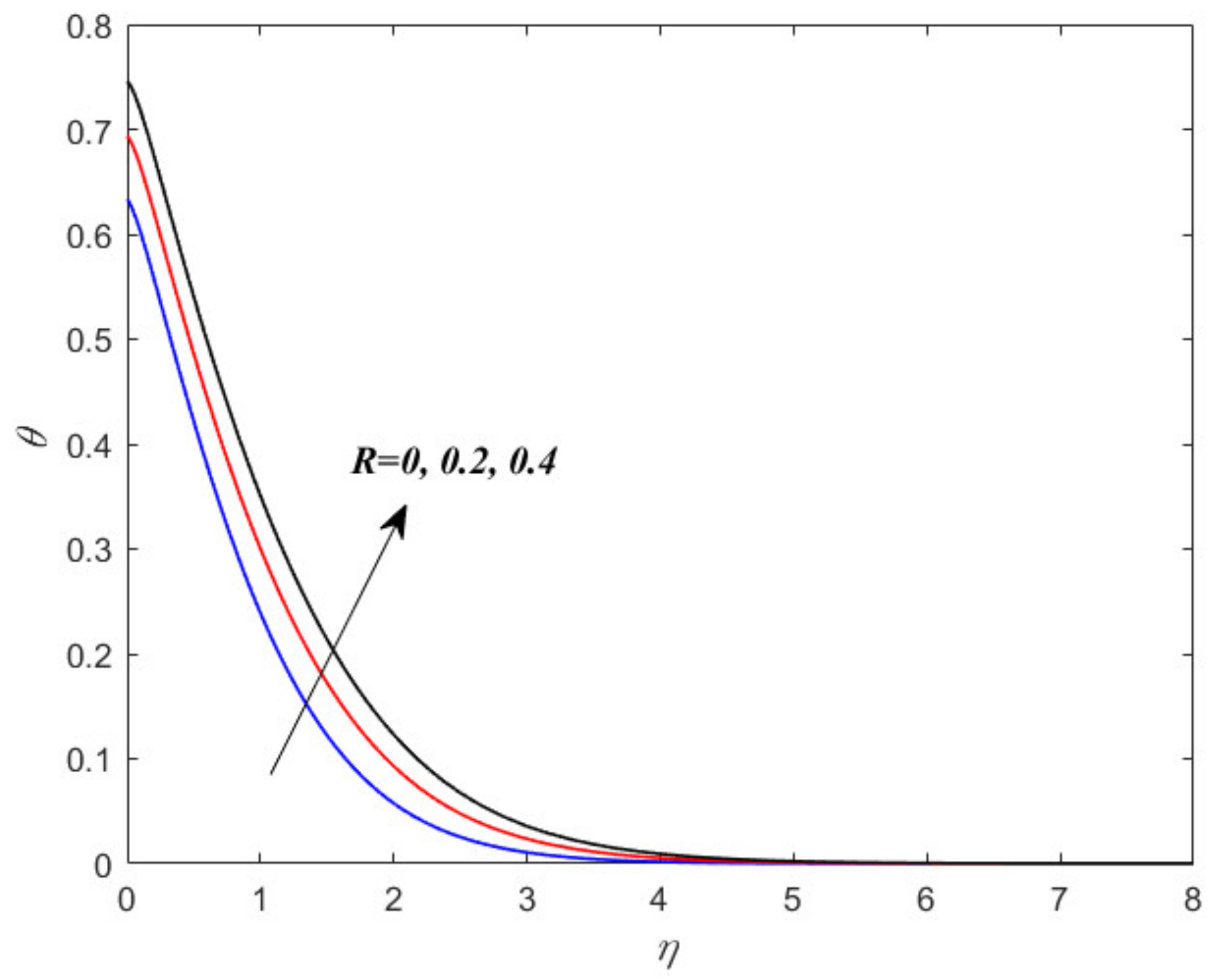
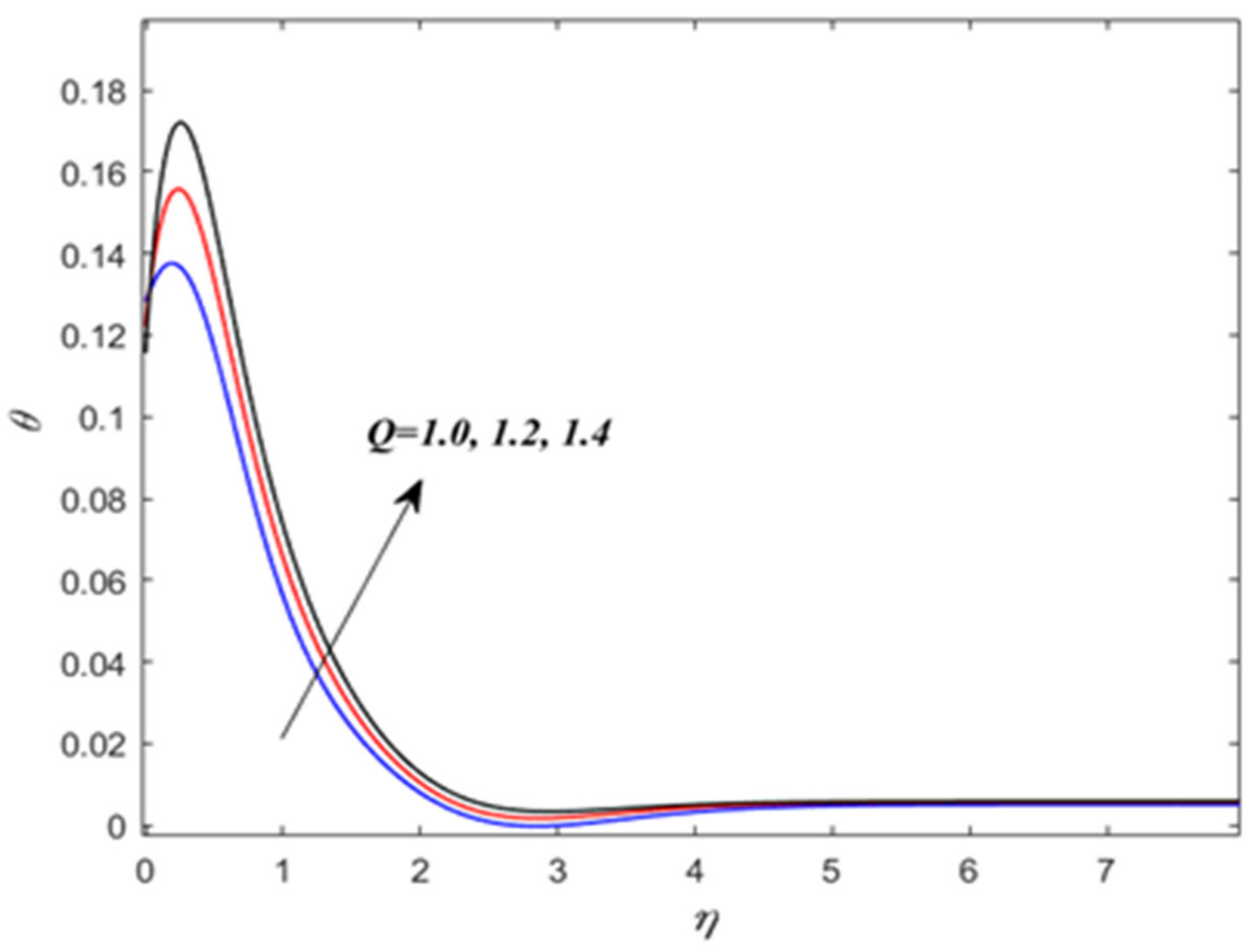
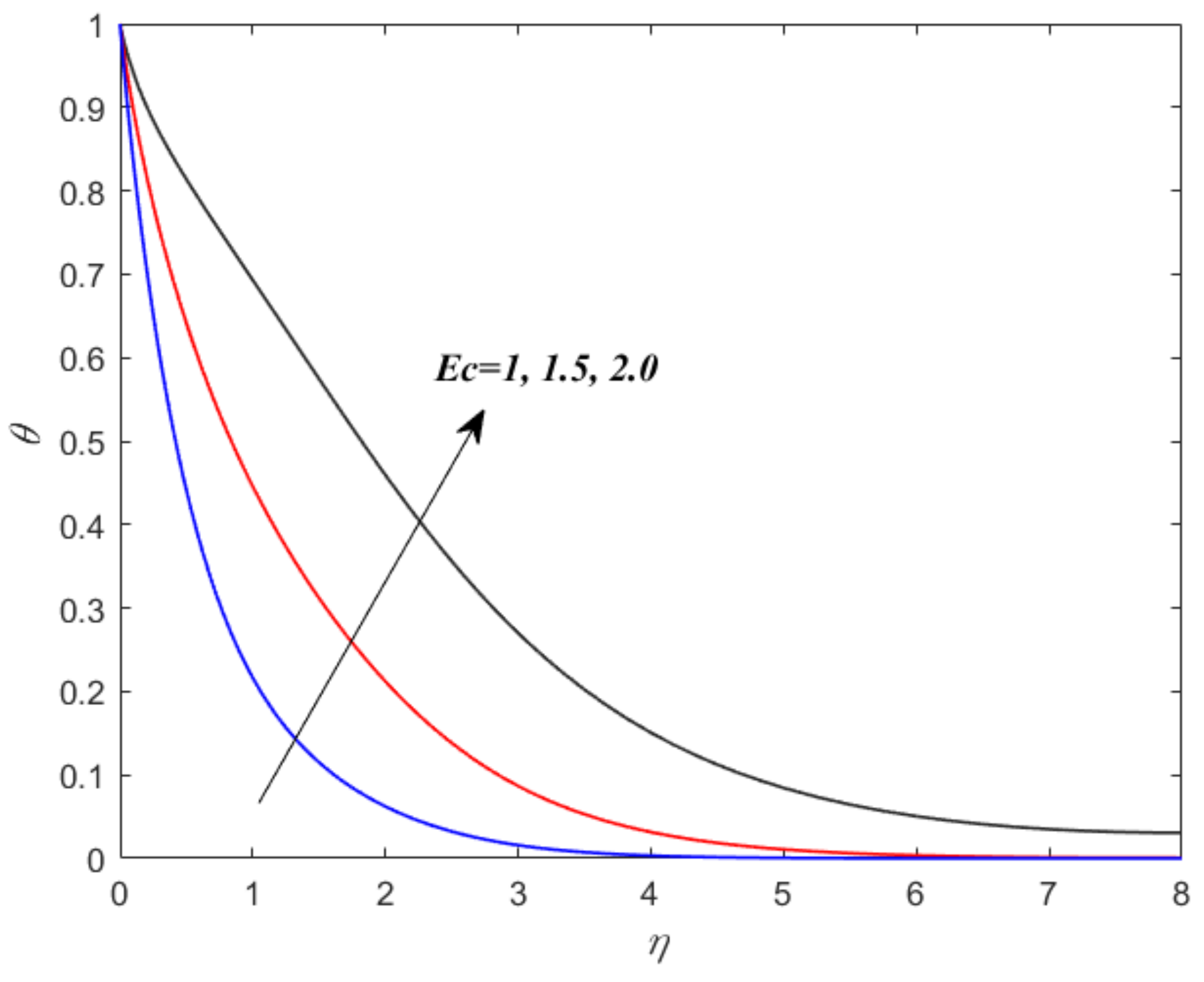
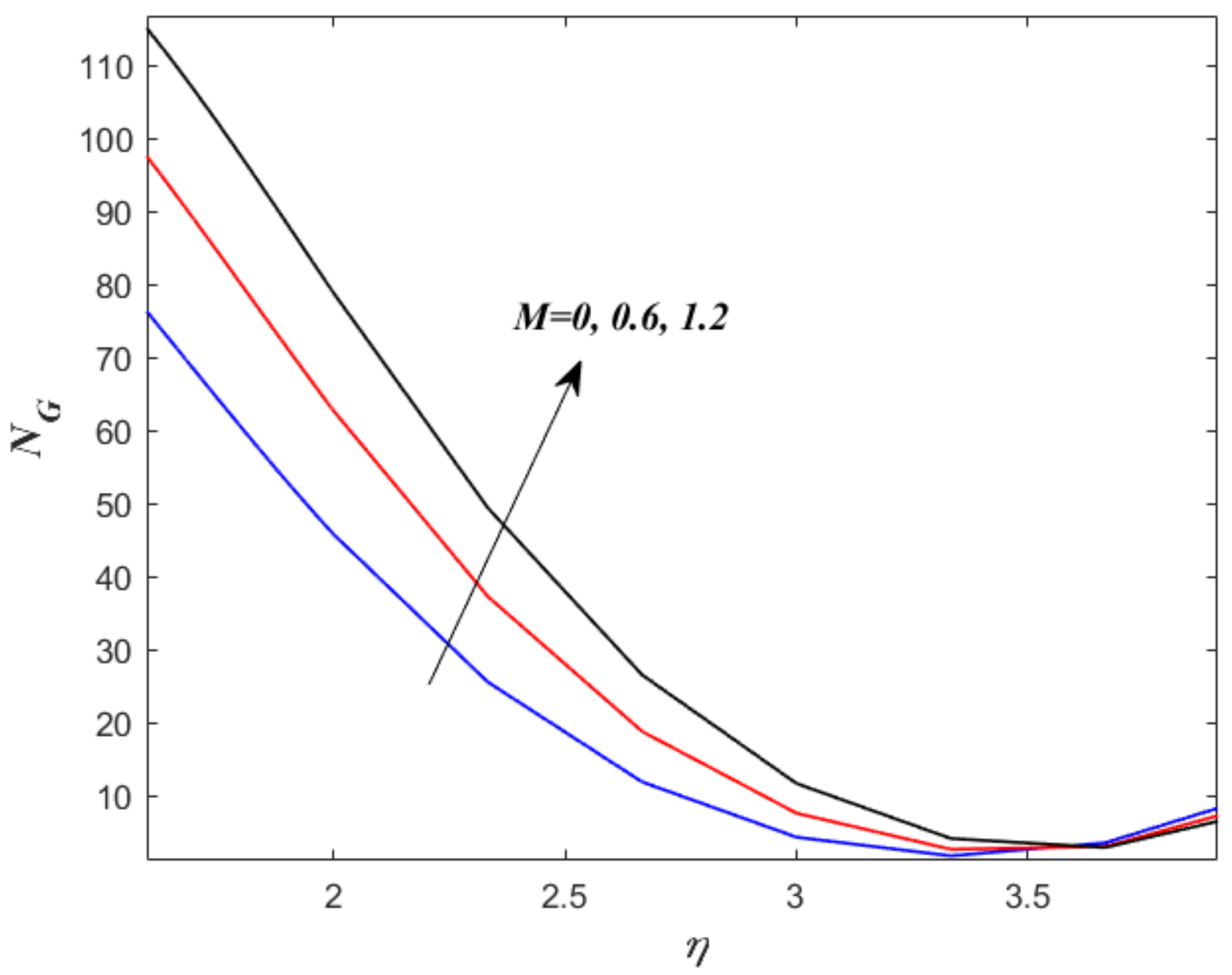
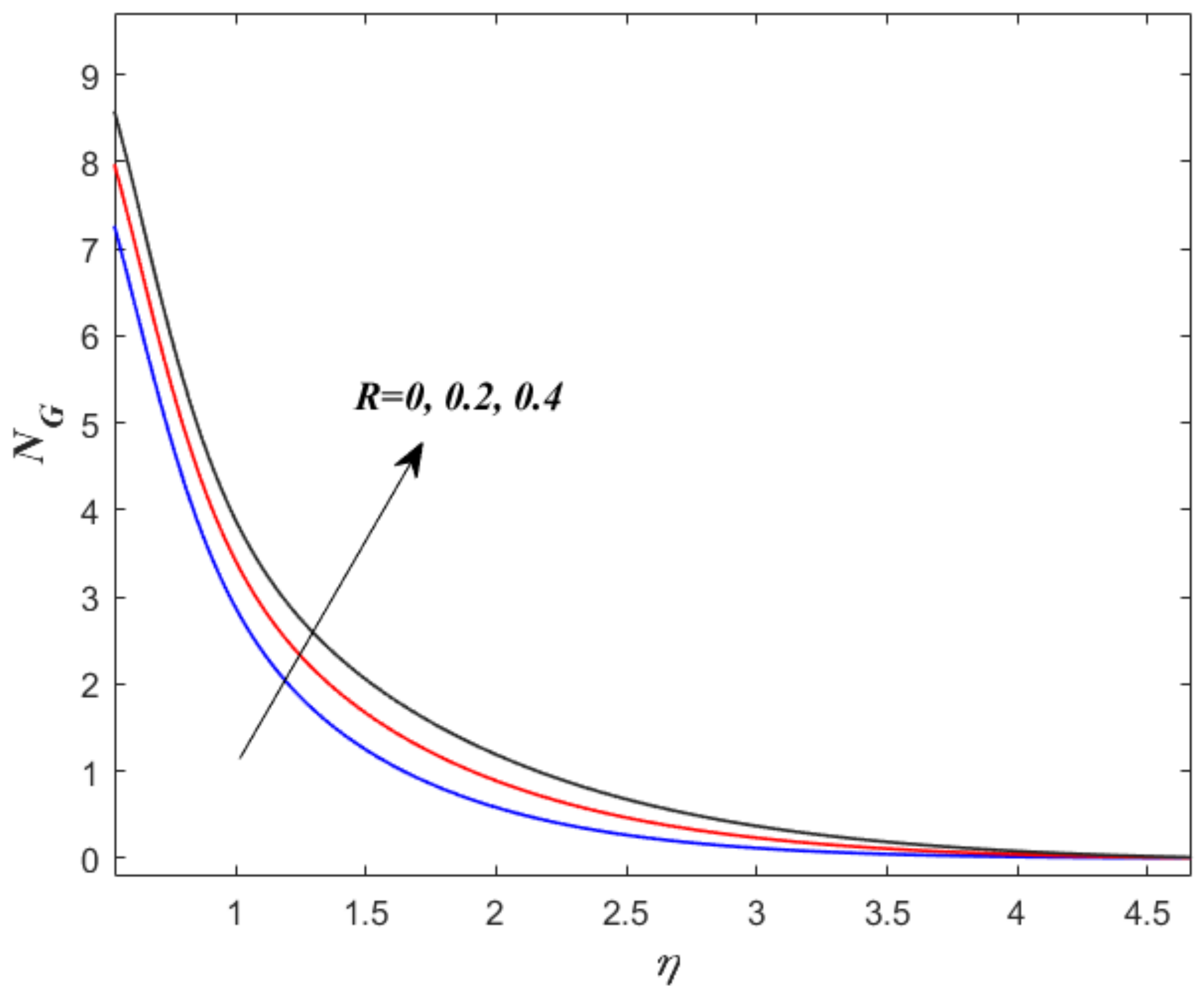
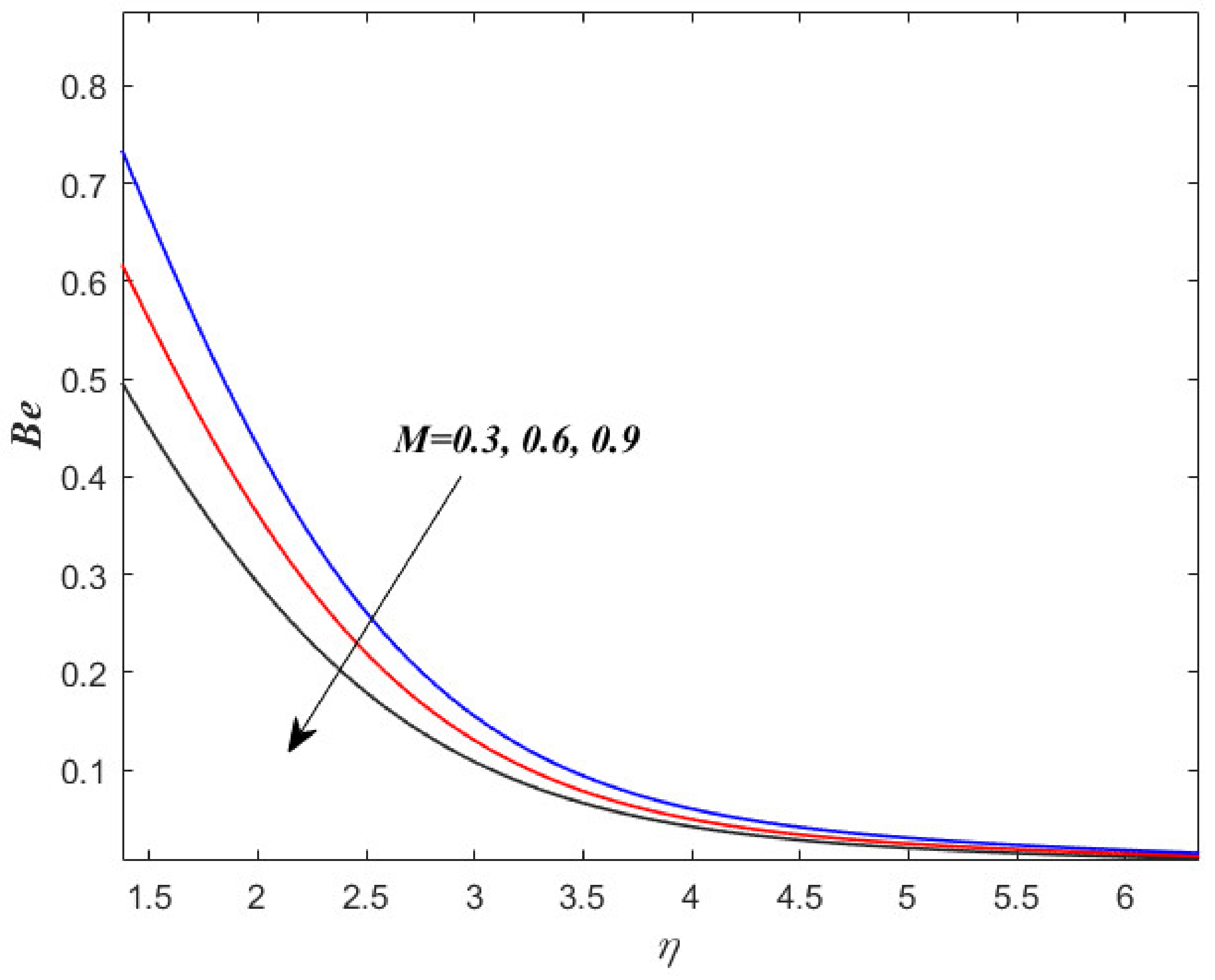
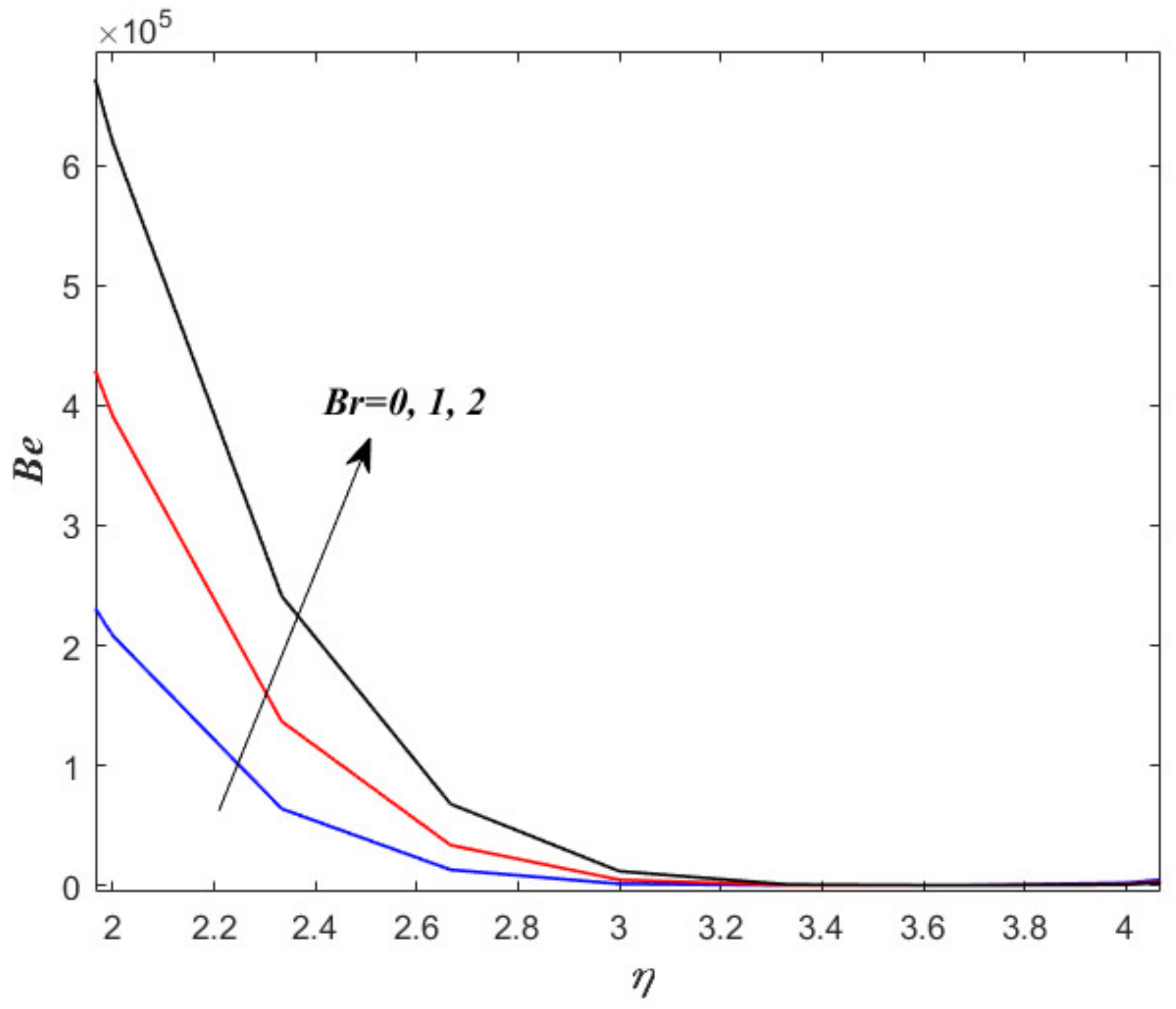
| Thermophysical Property | ||||
|---|---|---|---|---|
| 997.1 | 4180 | 0.613 | 0.05 | |
| 8933 | 385 | 401 | 59.5 × 106 | |
| 3970 | 765 | 40 | 35 × 106 |
| S. No | |||
|---|---|---|---|
| MATLAB | HPM | ||
| 1 | 0.0 | 1.000003 | 1.000003 |
| 2 | 0.1 | 1.000536 | 1.000195 |
| 3 | 0.2 | 1.000459 | 1.000402 |
| 4 | 0.3 | 1.000098 | 1.000086 |
| 5 | 0.4 | 1.000005 | 1.000019 |
Publisher’s Note: MDPI stays neutral with regard to jurisdictional claims in published maps and institutional affiliations. |
© 2022 by the authors. Licensee MDPI, Basel, Switzerland. This article is an open access article distributed under the terms and conditions of the Creative Commons Attribution (CC BY) license (https://creativecommons.org/licenses/by/4.0/).
Share and Cite
Kayalvizhi, J.; Vijaya Kumar, A.G. Entropy Analysis of EMHD Hybrid Nanofluid Stagnation Point Flow over a Porous Stretching Sheet with Melting Heat Transfer in the Presence of Thermal Radiation. Energies 2022, 15, 8317. https://doi.org/10.3390/en15218317
Kayalvizhi J, Vijaya Kumar AG. Entropy Analysis of EMHD Hybrid Nanofluid Stagnation Point Flow over a Porous Stretching Sheet with Melting Heat Transfer in the Presence of Thermal Radiation. Energies. 2022; 15(21):8317. https://doi.org/10.3390/en15218317
Chicago/Turabian StyleKayalvizhi, J., and A. G. Vijaya Kumar. 2022. "Entropy Analysis of EMHD Hybrid Nanofluid Stagnation Point Flow over a Porous Stretching Sheet with Melting Heat Transfer in the Presence of Thermal Radiation" Energies 15, no. 21: 8317. https://doi.org/10.3390/en15218317
APA StyleKayalvizhi, J., & Vijaya Kumar, A. G. (2022). Entropy Analysis of EMHD Hybrid Nanofluid Stagnation Point Flow over a Porous Stretching Sheet with Melting Heat Transfer in the Presence of Thermal Radiation. Energies, 15(21), 8317. https://doi.org/10.3390/en15218317





